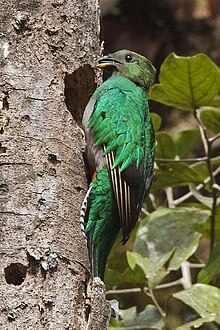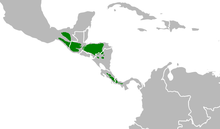| Resplendent quetzal | |
|---|---|

| |
| Male in Monteverde, Costa Rica | |

| |
| Female at nest hole in Savegre, Costa Rica | |
| Scientific classification | |
| Domain: | Eukaryota |
| Kingdom: | Animalia |
| Phylum: | Chordata |
| Class: | Aves |
| Order: | Trogoniformes |
| Family: | Trogonidae |
| Genus: | Pharomachrus |
| Species: | P. mocinno
|
| Binomial name | |
| Pharomachrus mocinno de la Llave, 1832[3]
| |
| Subspecies | |
|
Pharomachrus mocinno costaricensis | |

| |
| Range of P. mocinno | |
The resplendent quetzal (Pharomachrus mocinno) is a small bird found in Central America and southern Mexico that lives in tropical forests, particularly montane cloud forests. They are part of the family Trogonidae and have two recognized subspecies, P. m. mocinno and P. m. costaricensis. Like other quetzals, the resplendent is mostly omnivorous; its diet mainly consists of fruits of plants in the laurel family, Lauraceae, but it occasionally also preys on insects, lizards, frogs and snails.
The species is well known for its colorful and complex plumage that differs substantially between sexes. Males have iridescent green plumes, a red lower breast and belly, black innerwings and a white undertail, whilst females are duller and have a shorter tail. Grey lower breasts, bellies, and bills, along with bronze-green heads are characteristic of females. These birds hollow holes in decaying trees or use ones already made by woodpeckers as a nest site. They are known to take turns while incubating, males throughout the day and females at night. The female usually lays one to three eggs, which hatch in 17 to 19 days. The quetzal is an altitudinal migrant, migrating from the slopes to the canopy of the forest. This occurs during the breeding season, which varies depending on the location, but usually commences in March and extends as far as August.
The resplendent quetzal is considered near threatened on the IUCN Red List, with habitat destruction being the main threat. It has an important role in Mesoamerican mythology, and is closely associated with Quetzalcoatl, a deity. It is the national animal of Guatemala, being pictured on the flag and coat of arms; it also gives its name to the country's currency, the Guatemalan quetzal.
- ^ BirdLife International (2016). "Pharomachrus mocinno". IUCN Red List of Threatened Species. 2016: e.T22682727A92958465. doi:10.2305/IUCN.UK.2016-3.RLTS.T22682727A92958465.en. Retrieved 12 November 2021.
- ^ "Appendices | CITES". cites.org. Retrieved 2022-01-14.
- ^ Cite error: The named reference
ITISwas invoked but never defined (see the help page).
